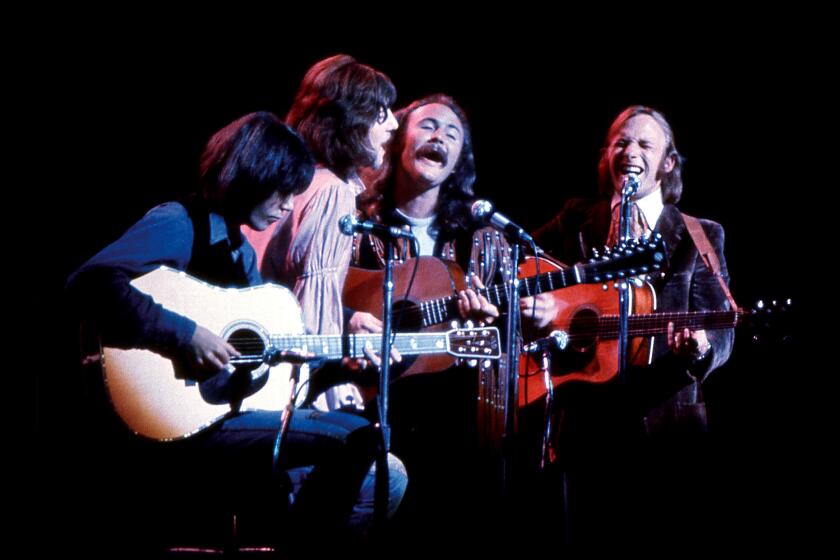The 1960s Dilexi Gallery, raw and radical, gets brought back to life
- Share via
Retrospective exhibitions typically trace the career of an individual artist, but the format applies equally well to the lifespan of a gallery, as evidenced by “Dilexi Gallery: Disparate Ontologies” at the L.A. gallery the Landing.
Organized by independent curator Laura Whitcomb, the show is part of a six-venue program examining the evolution and character of Dilexi, which operated in San Francisco from 1958 to 1969 as well as in Los Angeles briefly in the early ‘60s. The Landing’s show, like the project as a whole (a comprehensive catalog is forthcoming), is a vibrant lesson in art history-cum-astronomy, a tale of radiant bodies, constellations and orbits.
The first revelatory big bang came in 1950, when music student Jim Newman met fellow Stanford freshman Walter Hopps. Friendship and collaboration ensued. Hopps launched the legendary Ferus Gallery in L.A. in 1957, and the next year Newman (with poet, artist and activist Bob Alexander) opened Dilexi above a jazz club. Newman later described the venture as “performing more of a missionary or even maybe a political function” than a commercial one. He was drawn to artists — largely Californians — whom he perceived as radical in intent and bold with materials. A New York Times critic called the gallery “a springboard for the hairy avant-garde.”
Professional nonconformism seems to have been the gallery’s ethos. According to one exhibition announcement, Dilexi stayed open until midnight.
The retrospective’s venues include some overlaps. Parker Gallery in L.A. has “Seeking the Unknown,” featuring Jess, Roy De Forest, Wally Hedrick, Jeremy Anderson and Alfred Jensen; the L.A. gallery Parrasch Heijnen’s “Totems and Phenomenology” showcases Tony DeLap, Charles Ross, Deborah Remington, Arlo Acton and Richard Van Buren. Both of those shows run through Aug. 10. Marc Selwyn Fine Art in Beverly Hills pairs Jay DeFeo and Craig Kauffman through Sept. 14. (Two Dilexi shows ran recently in San Francisco.)
The Landing’s spread is diverse and richly textured, largely oriented toward raw interiority, with nods to social critique and the surreal. “March or Die,” H.C. Westermann’s 1966 sculpture in wood, leather, metal and ink, is a beauty, tight and tough. Joe Goode’s now-classic milk bottle paintings were first shown at Dilexi’s L.A. outpost; “Bo” (1962), here, is a stellar example of the series. Leslie Kerr’s painting, “Ouch” (1964), is a tidy piece of pop abstraction.
If one work could emblematize the whole Dilexi enterprise, it might be Harry Kramer’s wondrous motorized sculpture, “Lindwurm 2” (1964). A biomorphic tubular loop made of a delicately gridded wire skin, the piece is the work of an ingenious hand but feels also like the embodiment of something deeper, more broadly fundamental to being. Inside the exoskeleton, a dozen wheels turn with a gentle, musical ticking. A harmonious marriage of the organic and mechanical, the entrancing device functions like a kind of clockwork, at once earthly and celestial.
When Newman closed the gallery (Alexander remained a partner for less than a year), he established the Dilexi Foundation, aiming to broaden art’s reach, to narrow the gap between art and life. He created a series on the PBS station KQED, broadcasting artists’ film projects. Five of them, by Yvonne Rainer, Andy Warhol, Walter De Maria and others, screen in the gallery. However counterculture his artists, Newman wanted to make a place for them front and center. He proclaimed, upon announcing the foundation: “The art world has become small and irrelevant against the general conditions of things in the world. Art ... should be in the way, not hidden.” Amen.
On View
'Dilexi Gallery: Disparate Ontologies'
Where: The Landing, 5118 W. Jefferson Blvd., L.A.
When: Open Wednesdays-Saturdays, through Aug. 10
Info: (323) 272-3194, thelandinggallery.com
Support our coverage of the SoCal art scene by becoming a digital subscriber.
More to Read
The biggest entertainment stories
Get our big stories about Hollywood, film, television, music, arts, culture and more right in your inbox as soon as they publish.
You may occasionally receive promotional content from the Los Angeles Times.










